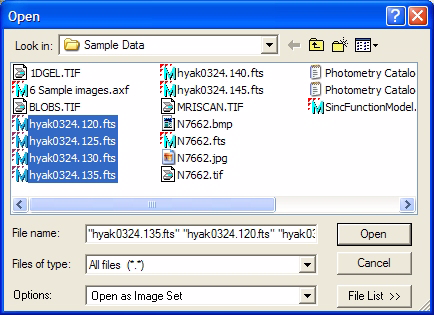
Displaying Your First Image Set
This tutorial extends the concepts learned in Displaying Your First Image. Here you will learn how to open multiple images to work them as an Image Set, animate them like a movie, make some measurements, and save the files.
Click File > Open... in the pull-down menu. This displays the familiar Open dialog shown below. Select the 4 images as shown below and click [Open].
Note: Marking these 4 files involves the standard Windows multi-selection protocol using the [Shift] key. To mark files that are not in a contiguous block, use the [Ctrl] and [Shift] keys.

At the bottom of the dialog, notice that Open as Image Set option is enabled (drop the listbox to see it as a checkbox option). This instructs Mira to load the selected images into the same Image Window. Multiple images constitute an Image Set, which is a Mira concept for working with multiple images as one object. If the Load As Image Set item is not checked, then the selected files are opened "traditionally" into different windows. Since an Image Set is chosen, the Image Window opens with an Animation Toolbar along its bottom border. This toolbar lets you select the active image (that is, the one on top) or to move between them. You can switch between images one at a time or by playing them as a movie using a chosen frame rate and step.
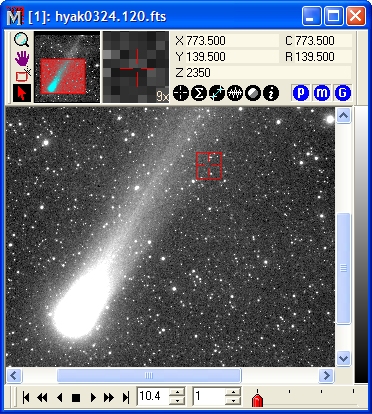
|
NOTE |
If a FITS format image opens upside down, open the Open dialog and check the Flip FITS Images option, then re-open the image. |
Mira AP provides tools for adding, deleting, and reordering the image set. These operations use commands in the Image Set submenu at the bottom of the Image Context Menu.
On the Animation Toolbar, click ![]() ("Fast Forward") to
animate the images in the forward direction through the Image Set.
If the toolbar appears as above, then the frames will be stepping
forward at 8.5 frames per second at a step of 1 (in other words,
every frame is shown). Now move the mouse pointer onto the Colormap
at the right side of the window, do mouse down, and adjust the
palette contrast and brightness while the images are animating (
you can also open the Palette Properties dialog and change the
palette or palette settings while animation is running). You can
also do things like re-center and magnify the images
during animation. And, of course, the coordinates continue to
update as you roam the pointer over the image. Next. let us slow
the animation rate to 4 frames per second. To do this, press and
hold the down arrow on the frame rate spin control. You will see
the frame rate reduce and the image animation will also slow. Now
stop the animation by clicking
("Fast Forward") to
animate the images in the forward direction through the Image Set.
If the toolbar appears as above, then the frames will be stepping
forward at 8.5 frames per second at a step of 1 (in other words,
every frame is shown). Now move the mouse pointer onto the Colormap
at the right side of the window, do mouse down, and adjust the
palette contrast and brightness while the images are animating (
you can also open the Palette Properties dialog and change the
palette or palette settings while animation is running). You can
also do things like re-center and magnify the images
during animation. And, of course, the coordinates continue to
update as you roam the pointer over the image. Next. let us slow
the animation rate to 4 frames per second. To do this, press and
hold the down arrow on the frame rate spin control. You will see
the frame rate reduce and the image animation will also slow. Now
stop the animation by clicking
![]() on the animation toolbar. Let's
step forward through the images by
clicking the
on the animation toolbar. Let's
step forward through the images by
clicking the ![]() button. As you do this,
new images move to the top of the stack where they become the
"active image" for the image set loaded into the window. The same
result can be achieved by moving the red trackbar on the right side
of the toolbar.
button. As you do this,
new images move to the top of the stack where they become the
"active image" for the image set loaded into the window. The same
result can be achieved by moving the red trackbar on the right side
of the toolbar.
Now that we have opened an image set, let's see how we can easily work with this same image set in the future. Click File > Open to go back to the Open dialog. If we had any plans to use this same set of image in the future, here is what we should have done in the first place: Create a File List containing the target images. The File List contains the full path name of selected files. Mira works with a File List just a like a file, except that it knows that the File List contains the names of the actual files. So we will now create a File List: Select the 4 images as shown above and click [File List >>] on the bottom of the dialog. This opens the dialog shown below.
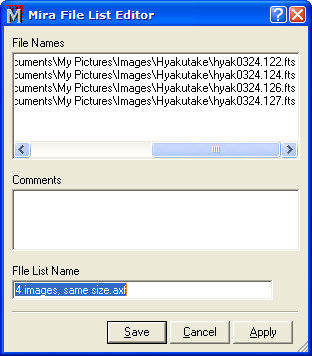
I the above figure the path names are scrolled to the right to show the file name on the right end. As you can see, the Comments and File List Name fields are initially blank. To create a File List, you must enter a name into the File List Name field and optionally, you can add some comments to the Comments field. When you are finished, click [Save] to save the new File List and return to the Open dialog. In the Open dialog, there is a new file with the name you gave to the File List. Here we have named it 4 Hyakutake files; when you click Open, Mira creates a file named '4 Hyakutake files.axf' as shown below. In the future, you will be able to use these same 4 images simply by selecting the File List file. Do this now: Select the File List as shown below and click [Open].
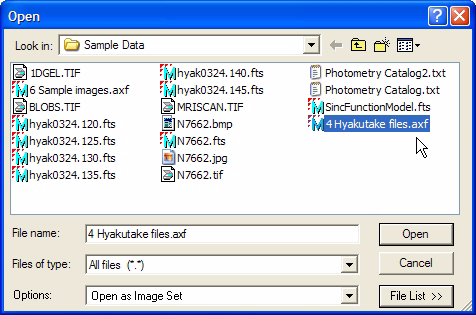
There are more things you can do with a File List, such as opening two of them into the same window. See Working with File Lists.
Now let us measure the statistics in the same
rectangular region of interest on the 4 images that we just loaded.
To do this, make sure the Image Window containing the 4 images has
the focus (in other words, it is on top of the stack). On the Image
Toolbar, there are two buttons to use. First, check that ![]() is pressed (blue color). This
instructs Mira whether to measure the entire image set. Next click
is pressed (blue color). This
instructs Mira whether to measure the entire image set. Next click
![]() to perform the measurement. The
statistics you have measured appear in the Statistics Report
window shown below. See Statistics Measurements for more information
about what we can do with this information.
to perform the measurement. The
statistics you have measured appear in the Statistics Report
window shown below. See Statistics Measurements for more information
about what we can do with this information.

Of course, the region being measured may be changed
by adjusting the Image
Cursor and then re-measuring. Additional statistics
measurements are written to this same window. You can also measure
only 1 image by popping out the ![]() so that it appears black. You can
determine the current state of this Image Set Flag by letting the mouse pointer
hover over the button. The
so that it appears black. You can
determine the current state of this Image Set Flag by letting the mouse pointer
hover over the button. The ![]() button
is similar except that it controls processing rather than measuring
and plotting.
button
is similar except that it controls processing rather than measuring
and plotting.
One of the many types of plots Mira can display is
a Row Profile Plot, which shows the variation in image luminance
along a row. The Column Profile Plot shows the variation along a
column. For Column Profile Plots and Row Profile Plots, and
for some other plots and measurements, the region of interest is
marked using the Image
Cursor. Before making the plot, we must answer the following
question: Do we want to plot the average row profile for a single
image or do we want to plot the same row profile for the entire
image set? The choice is made using the Image
Set Plot button ![]() on the
Image Toolbar.
Click the
on the
Image Toolbar.
Click the ![]() button to pop it
out and turn off image set plotting. That way, only the current
image will be plotted. Clicking
button to pop it
out and turn off image set plotting. That way, only the current
image will be plotted. Clicking ![]() then plots a single row at the center
of the Image Cursor. This button executes the Row Profile Plot
command. If instead, you clicked
then plots a single row at the center
of the Image Cursor. This button executes the Row Profile Plot
command. If instead, you clicked ![]() to make it appear pressed, then you
would get 4 plot series, one at the same position in each member of
the image set, as shown below. Notice in the plot caption (not the
window caption) that [497:548, 516]
reminds us that we plotted between columns 497 and 548, along row
516. This plot shows only row 516 for all members of the
image set.
to make it appear pressed, then you
would get 4 plot series, one at the same position in each member of
the image set, as shown below. Notice in the plot caption (not the
window caption) that [497:548, 516]
reminds us that we plotted between columns 497 and 548, along row
516. This plot shows only row 516 for all members of the
image set.
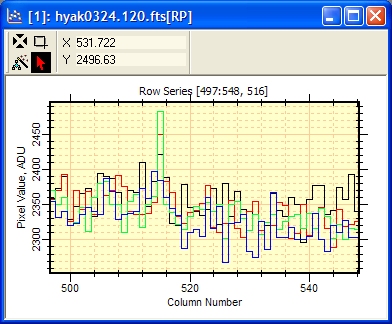
In the window above, each plot series uses a different color. You can choose these colors or set them all to the same color using the Plot Attributes dialog. You can also animate the plot series much as you would the Image Set using the Plot Animation Toolbar. Notice that the window title has the suffix [RP], which means "Row Profile".
Another interesting plot might be the Average Row Profile,
which plots the mathematical average of all rows inside the Image
Cursor. To choose the active image or all images, we again set the
![]() button accordingly. The figure
below shows the Average Row Profile ([ARP]) inside the same Image
Cursor region.
button accordingly. The figure
below shows the Average Row Profile ([ARP]) inside the same Image
Cursor region.
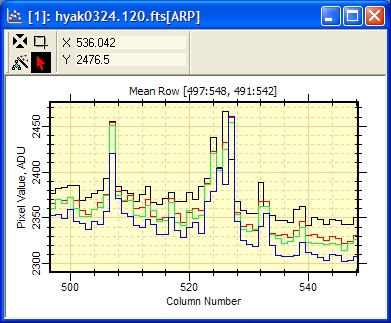
Finally, lets suppose we performed some processing on the image set images and we will save the images back to files. We can save to the original files or to other files. The alternatives are described in Saving Image Sets. Here will will save the image set over the original files: Click File > Save Image Set > Save All. Using other commands in the Save Image Set submenu, we can save all images to a different folder or we can append a suffix to the file names.